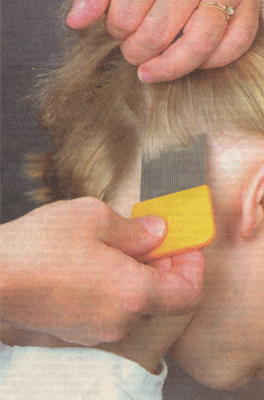| The
triage nurses at the Pediatric Center cringe when they have to return a
call from a parent about head lice.
 |
| TIPS
FOR PARENTS |
Dr. Julianne Thomas, Cedar Rapids pediatrician, offers
the following advice to help parents win the battle against
head lice:
- Check your children's hair routinely, especially when
you notice them itching their scalp.
- Encourage your children not to share hats, combs,
brushes or any hair products.
- Removal of lice and nits is the key, so thorough,
diligent combing with a quality lice removal comb is a must.
- Wash bedding, combs, brushes and hair products of the
infected child.
- Consider cutting your child's hair to make removal of
lice and nits easier.
Lice can`t jump or fly
Misconceptions about head
lice are almost as tough to clear up as the little critters.
Some of the most common ones are shared here by Deborah
Altschuler, president of the National Pediculosis Association
of Needham, Mass.:
- People think lice can fly, but they have no wings. Also,
they cannot jump.
- People think that a person must be dirty to have head
lice. Lice are not particular about clean or dirty heads.
- People think lice can infest their homes and schools.
Lice infest only people.
- People think you can get them from dirt. Lice need human
blood to survive.
- People think over-the-counter treatments are effective
in killing lice and nits, which is not true.
-
People cannot get head lice from animals, such as dogs
or cats.
|
It's
not the nature of the bug that causes that reaction. It's that they know
the parent on the other end of the line is going to be extremely
frustrated, says Dr. Julianne Thomas of the Cedar Rapids office.
Calls, she adds, are more frequent this time of year because kids are
back at school and are, literally, "putting their heads together." But,
she adds, head lice occur "every year, every month, every day."
More and more, the parasitic insects are grasping hair shafts and not
letting go. Like certain bacteria resistant to antibiotics, Pediculus
capitis is often resistant to shampoos and other products that once
worked.
Thomas says there is no sure-fire method for preventing head lice. "I
have moms who are pharmacists who are searching the Web" for answers, she
says. "It is just an extremely frustrating nuisance problem."
To Deborah Altschuler, president of the National Pediculosis
Association (NPA), Needham, Mass., there is only one answer: early
detection with diligent, thorough combing of the hair with a quality lice
and nit removal comb. NPA endorses a comb called the LiceMeister, which
often is found in the offices of school nurses. The comb has closely
spaced stainless steel teeth that glide easily through the hair,
collecting lice and nits along the way. The comb can be purchased at NPA's Web site, www.headlice.org.
Altschuler started NPA in 1983 after a frustrating case of head lice
with her own children. She says she was "horrified" when she began
investigating what was in the products she used.
Parents, Altschuler says, often buy lice shampoos and environmental
lice sprays because they are panicked. "They tend to run in a harried way
to the drug store and make the assumption if it's on the shelves, then
it's probably OK, without the appreciation that the products are designed
to kill organisms and are pesticidal."
The NPA petitioned the Food and Drug Association in 1983 for a ban of
lice products that contain lindane, an insecticide. In 1996, the FDA
called for lindane products to be used only as a last resort. This alert,
she adds, was a warning about lindane safety and was not intended to mean
that lindane be used after other products fail.
She cautions parents, too, against buying products that are said to be
alternative, natural products. She calls it an oxymoron that the products
are marketed as 100 percent safe and natural, but kill lice and nits.
Typically, parents dealing with head lice are told to try
over-the-counter shampoos like Nix or Rid, then to comb through the hair
with a lice and nit removal comb. They are encouraged to retreat the hair
in seven to 10 days.
Altschuler maintains the shampoos have not been proven to be effective
so are an unnecessary expense. Combing, she believes, is the key. "Why not start there?" she asks. Doing so may
help parents avoid using chemicals altogether, she adds.
She knows some will say she is only trying to plug the NPA's
LiceMeister comb. Altschuler says she is guilty as charged. To her, it's
the best lice and nit removal comb on the market. But, she adds, it does
not carry a 100-percent effectiveness guarantee either. The comb is only
as good as the parent using it, she says. In other words, parents must be
combing regularly to remove lice and eggs.
The NPA's annual Back-to-School Head Lice Prevention Campaign
calls for an "All Out Comb Out" for September. The emphasis is on early
detection as the best edge against the head louse and its nits. The NPA
wants head lice screenings to be part of routine hygiene.
Cedar Rapids' Thomas says parents often are unwilling to put in the
time necessary to remove nits and lice. They also are unwilling to cut
their children's hair. Shaving a child's hair isn't necessary, Thomas
says. But cutting a child's hair shorter will make it easier to find the
critters and their eggs.
"They want to survive," Thomas says of lice. "It's survival of the
fittest."
But Altschuler thinks cutting hair is unwarranted. "Cutting (hair) can
be traumatic for the kids and not necessarily helpful," she says. "If it's
helpful it's because less hair is less hair. Better to stick with
screening often."
|